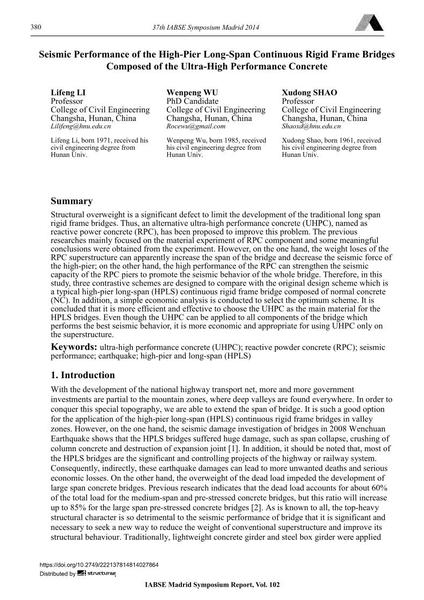Seismic Performance of the High-Pier Long-Span Continuous Rigid Frame Bridges Composed of the Ultra-High Performance Concrete

|
|
|||||||||||
Détails bibliographiques
| Auteur(s): |
Lifeng Li
Wenpeng Wu Xudong Shao |
||||
|---|---|---|---|---|---|
| Médium: | papier de conférence | ||||
| Langue(s): | anglais | ||||
| Conférence: | IABSE Symposium: Engineering for Progress, Nature and People, Madrid, Spain, 3-5 September 2014 | ||||
| Publié dans: | IABSE Symposium Madrid 2014 | ||||
|
|||||
| Page(s): | 380-387 | ||||
| Nombre total de pages (du PDF): | 8 | ||||
| Année: | 2014 | ||||
| DOI: | 10.2749/222137814814027864 | ||||
| Abstrait: |
Structural overweight is a significant defect to limit the development of the traditional long span rigid frame bridges. Thus, an alternative ultra-high performance concrete (UHPC), named as reactive power concrete (RPC), has been proposed to improve this problem. The previous researches mainly focused on the material experiment of RPC component and some meaningful conclusions were obtained from the experiment. However, on the one hand, the weight loses of the RPC superstructure can apparently increase the span of the bridge and decrease the seismic force of the high-pier; on the other hand, the high performance of the RPC can strengthen the seismic capacity of the RPC piers to promote the seismic behavior of the whole bridge. Therefore, in this study, three contrastive schemes are designed to compare with the original design scheme which is a typical high-pier long-span (HPLS) continuous rigid frame bridge composed of normal concrete (NC). In addition, a simple economic analysis is conducted to select the optimum scheme. It is concluded that it is more efficient and effective to choose the UHPC as the main material for the HPLS bridges. Even though the UHPC can be applied to all components of the bridge which performs the best seismic behavior, it is more economic and appropriate for using UHPC only on the superstructure. |
||||
| Mots-clé: |
tremblement de terre
|
||||
